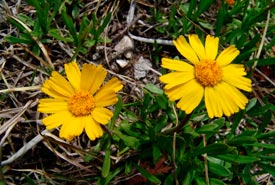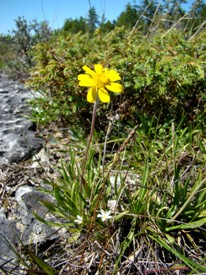
Lakeside daisy (Photo by Charles Peirce)
Lakeside daisy
This bright yellow flower that blooms in early spring is globally rare and found only along the Great Lakes. In Canada, it occurs only on the grasslands and pavement alvars of the Saugeen Bruce Peninsula and Manitoulin Island in Ontario. These populations of lakeside daisy account for about 95 per cent of the populations existing in the world. It is also one of very few plant species with most of its global range in Ontario.
Where is lakeside daisy found?
The lakeside daisy is found mostly in alvars: naturally open areas with either a thin layer of soil or no soil over a base of limestone or dolostone bedrock. Alvars are a globally imperilled ecosystem. In addition to the Great Lakes region, alvars have recently been discovered in Manitoba and Saskatchewan. Alvars support many rare and threatened species, including lakeside daisy.
Lakeside daisies grow on pavement alvars, among a mosaic of exposed rock covered in lichen and moss. Grykes, joint fractures in the rock shaped by water erosion, are home to many of the wildflowers, ferns and other plants found on pavement alvars. Soil accumulates over time in these cracks to allow for plants like low calamint, maidenhair spleenwort and lakeside daisy to take root. This unique habitat is kept open through natural disturbances, such as floods, drought, fire and wind, which limit the growth of trees and shrubs that would otherwise shade out sun-loving plants like lakeside daisy.
Thriving on adversity

Lakeside daisy, Manitoulin Island, Ontario (Photo by NCC)
Like many of the plant and animal species found on alvars, lakeside daisies are able to survive harsh conditions: spring floods, summer droughts and temperatures as high as 52 C. Due to the extreme variations in temperature, moisture and disturbance on alvars, specially adapted plants and animals can thrive in this habitat.
What is the conservation status of this species?
The lakeside daisy is listed as threatened under the Endangered Species Act in Ontario, and special concern federally under the Species at Risk Act. While it has a very small range, many sites have now been protected. But lakeside daisy is still threatened by habitat loss and invasive species.
Lakeside daisies are also found along shorelines and inland areas that are popular for hiking and recreation, areas where they can be accidentally trampled. The Nature Conservancy of Canada (NCC) has protected significant alvar habitat, including habitat for lakeside daisies, on Manitoulin Island. There are significant populations of this plant found on NCC’s Tasker Wilderness Shore property on Manitoulin Island. NCC is also working to control gold-moss and other invasive plants that threaten lakeside daisy.





